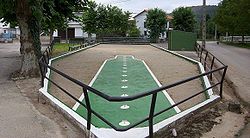
Bolo palma
Encyclopedia

Bowls
Bowls is a sport in which the objective is to roll slightly asymmetric balls so that they stop close to a smaller "jack" or "kitty". It is played on a pitch which may be flat or convex or uneven...
played throughout the north of Spain
Spain
Spain , officially the Kingdom of Spain languages]] under the European Charter for Regional or Minority Languages. In each of these, Spain's official name is as follows:;;;;;;), is a country and member state of the European Union located in southwestern Europe on the Iberian Peninsula...
. The game originated in Cantabria
Cantabria
Cantabria is a Spanish historical region and autonomous community with Santander as its capital city. It is bordered on the east by the Basque Autonomous Community , on the south by Castile and León , on the west by the Principality of Asturias, and on the north by the Cantabrian Sea.Cantabria...
but is also played in the neighbouring Asturias
Asturias
The Principality of Asturias is an autonomous community of the Kingdom of Spain, coextensive with the former Kingdom of Asturias in the Middle Ages...
and Basque Country. Records of the game go back as far as the 16th century. The basic aim of the game is the knock over as many pins as possible with a wooden ball.
The set-up
The playing field or bolera is between 30–34 m long and 8 m wide and roughly split into three areas, the zona de tiro (launch zone; jaurtitzeko aldea in BasqueBasque language
Basque is the ancestral language of the Basque people, who inhabit the Basque Country, a region spanning an area in northeastern Spain and southwestern France. It is spoken by 25.7% of Basques in all territories...
), the middle area or caja or zona de bolos and the zona de birle (pin zone; birlatzeko aldea in Basque
Basque language
Basque is the ancestral language of the Basque people, who inhabit the Basque Country, a region spanning an area in northeastern Spain and southwestern France. It is spoken by 25.7% of Basques in all territories...
).
The first section is the zona de tiro, the rectangular launching zone 8 m wide and 20 m long from where the players launch the ball. There are circles on the ground called tiros which mark different foot positions for the players.
The caja straddles the zona de tiro and the zona de birle at the far end. It also has a borderline to its front called fleje. Here, there are 9 wooden bolos (pins) with a metal base (argolla or anilla in Spanish
Spanish language
Spanish , also known as Castilian , is a Romance language in the Ibero-Romance group that evolved from several languages and dialects in central-northern Iberia around the 9th century and gradually spread with the expansion of the Kingdom of Castile into central and southern Iberia during the...
), about 45 cm tall and 5 cm diameter, weighing between 550-630g. These are placed on pegs in a 3x3 square exactly straddling both zonas. There is also a tenth pin called emboque or cachi (txakina in Basque
Basque language
Basque is the ancestral language of the Basque people, who inhabit the Basque Country, a region spanning an area in northeastern Spain and southwestern France. It is spoken by 25.7% of Basques in all territories...
) which is smaller and off to one side.
The ball itself is spherical, about 12–18 cm in diameter and made of oak, sometimes with a lead
Lead
Lead is a main-group element in the carbon group with the symbol Pb and atomic number 82. Lead is a soft, malleable poor metal. It is also counted as one of the heavy metals. Metallic lead has a bluish-white color after being freshly cut, but it soon tarnishes to a dull grayish color when exposed...
centre to make the ball heavier. It usually weighs between 1.5-2.3 kg.
The game
Every game consists of two phases:- Tiro: the shot, where the player launches the ball from the launching area.
- Birle: the second shot where the player is allowed to launch the ball again from the position it landed in the tiro.
In the first phase, the player stands on the tiro, at least 12 m and at the most 20 m away from the nearest pin depending on the distance selected. The player then launches the ball upwards into the air, employing a number of different techniques depending on whether the emboque is to the left or the right of the caja.
Any pin knocked over is worth one point but if only the central pin is knocked over, two points are won. After having thrown three balls, the player passes over to the zona de birle. They are then allowed to bowl the three balls again from where they fell in the first throw, a move called birlar (birlatu in Basque). If a ball comes to rest very close to two pins, a special move called segar in which the player knocks over the close pins while aiming for others.
A bola queda is a bad ball that cannot be re-thrown. The most common causes of a bad ball is a ball that touches the ground before crossing the fleje, a ball that lands on the fleje, when the ball does not cross the line of the emboque and when the ball first touches the ground to the right or left of the caja
There are a number of ways in which this game can be won, either by reaching an agreed number of knocked over pins (usually between 20 and 40), by throwing eight balls and meeting a variety of challenges and so on.

